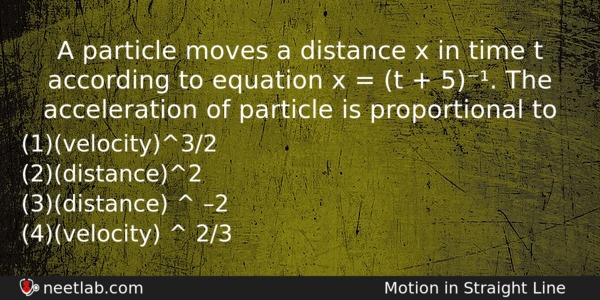| ⇦ | 
| ⇨ |
A particle moves a distance x in time t according to equation x = (t + 5)⁻¹. The acceleration of particle is proportional to
Options
(a) (velocity)^3/2
(b) (distance)^2
(c) (distance) ^ –2
(d) (velocity) ^ 2/3
Correct Answer:
(velocity)^3/2
Explanation:
x = 1 / t + 5
v = dx / dt = -1 / (t + 5)²
a = d²x / dt² = 2 / (t + 5)³ = 2x³
Now, 1 / (t + 5) ∞ v½
1 / (t + 5)³ ∞ v³/² ∞ a
Related Questions: - The electromagnetic theory of light failed to explain
- Planck’s constant has same dimensions as those of
- The electric field in a certain region is acting radially outward and is given by E=Ar.
- Dimensional formula for electrical resistance R is given by
- Two cities are 150 km apart. Electric power is sent from one city to another city
Topics: Motion in Straight Line
(93)
Subject: Physics
(2479)
Important MCQs Based on Medical Entrance Examinations To Improve Your NEET Score
- The electromagnetic theory of light failed to explain
- Planck’s constant has same dimensions as those of
- The electric field in a certain region is acting radially outward and is given by E=Ar.
- Dimensional formula for electrical resistance R is given by
- Two cities are 150 km apart. Electric power is sent from one city to another city
Topics: Motion in Straight Line (93)
Subject: Physics (2479)
Important MCQs Based on Medical Entrance Examinations To Improve Your NEET Score
18000+ students are using NEETLab to improve their score. What about you?
Solve Previous Year MCQs, Mock Tests, Topicwise Practice Tests, Identify Weak Topics, Formula Flash cards and much more is available in NEETLab Android App to improve your NEET score.
Share this page with your friends

Thankyou